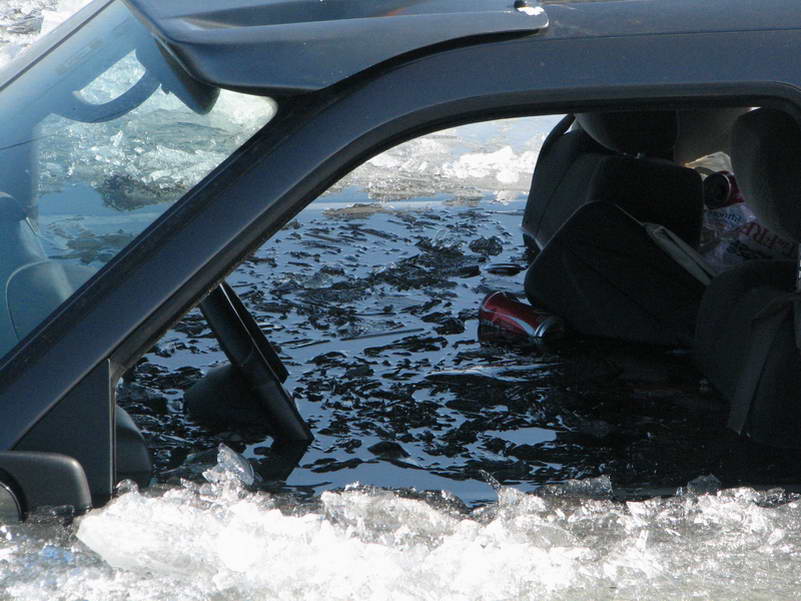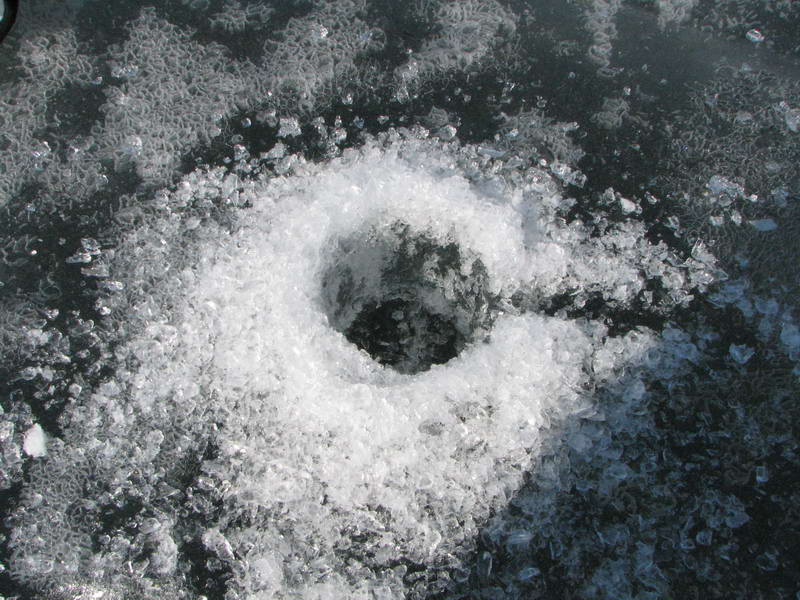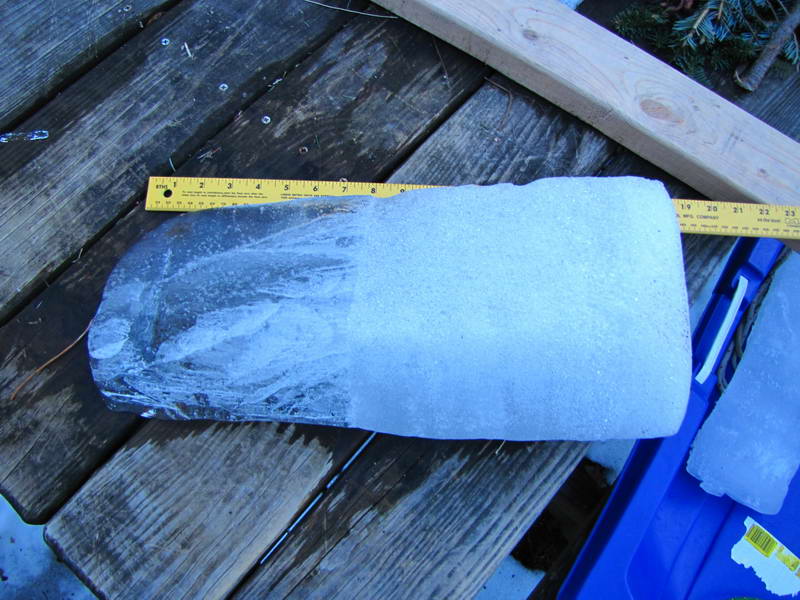Very rotten fine grained ice-Thaw stage 6). Thickness 13.5"
End of the Ice Season
Early April 2011
Now is an especially tricky time on the ice. It is quite possible to find yourself quite far out on ice that will not support you. Generally this plays out as follows: After a clear night the ice feels pretty solid in the moning (overnight ice). As the day warms up the hard surface layer that was providing strength to the ice sheet thaws and becomes weak. If the underlying ice is in an advanced thaw condition, the whole sheet can evolve in a couple hours from solid feeling ice to ice that won’t hold you up. The overnight temperature does not need to get below freezing to appear to solidify a well thawed ice sheet as radiational cooling can refreeze an inch of more of the surface of an ice sheet.
5-1/2" (14 cm) well thawed large grain ice (type S1). It is well past the point of being able to support body weight, even in a prone position. Note: This pond ice is less than half the thickness of ice on Lake Champlain that has been frozen less than half as long. Ponds often melt faster than deep lakes.
Thawing takes place at the surfaces of the crystals (grains). In snow ice the crystals are small, roughly spherical particles and the ice turns to mush in an advanced thaw state. Small grained ice, with its vertical crystal structure, a particularly weak ice called rotten candled Ice. The top picture is in ice that is 13.5" thick that failed under body weight. In some cases, once you punch a hole, the ice at the sides of the hole disintegrate into the hole making it more difficult to get back on the ice. Large grain ice holds up better but can get to the point where it is too weak as well.
Some suggestions if you are feeling compelled to go out:
- Ask yourself it is really worth going out one more time. Don’t expect great skating or sailing. There are likely to be holes and cracks. If you have underestimated hte amount of thawing you may find your self on rotten candeled ice. The ice is almost always rough and hard falls and ‘abrupt stops’ are common. Fishing can be nice in the warm sun but the walk back in can be dicey if you stay out a little too long.
- This is a particularly bad time to be in/on a vehicle.
 Shallow water, 7" fairly well thawed ice.
Shallow water, 7" fairly well thawed ice.
- Be prepared to fall through (throw rope, ice claws, companions, cold water clothing, lifejacket, test pole, etc).
- Don't count on any of that to save you if you are too far out and the ice is too far gone.
- Thoroughly check out the ice near shore so you have a reasonable idea of what you are dealing with.
- Expect trouble when moving from shaded ice to ice in the sun. Keep in mind that the shade line is moving.
- Ice around south facing shore lines is likely to be thinner, weaker or gone.
- Expect the ice strength and thickness to be variable
- Have a test pole and use it a lot.
- Go out early and get off early
- Don’t go out if the ice has been in an advanced thaw condition with a single night of overnight ice.
- Be especially wary of ice that is less than a foot thick or is mostly snow ice or small grain ice.
- Staying nearer to shore will make self-rescue or rescue by others more likely to be possible .
- Have companions and stay far enough apart that of one so you don't all fall through together.
 Water percolating into a partially drilled hole.
Water percolating into a partially drilled hole.
Checking the ice near shore by drilling it can be instructive. How quickly does a partially drilled hole fill? Are there puddles on the ice? Were there any puddles yesterday or is the ice sheet porous? How easy is it to poke through the bottom 3” of the sheet? If you can drill or saw out a vertical section of the ice you can test its integrity by dropping it on the ice.
 Chunky drill chips from well thawed small grain ice (still a day or three from being too weak to walk on)
Chunky drill chips from well thawed small grain ice (still a day or three from being too weak to walk on)
In early April, 2011 in Vermont we still have nearly 20 inches of ice on some of the bays on Lake Champlain. and smaller lakes that came in early. It is comprised of about 30-50% snow ice. Ice this late is relatively unusual in the lower elevation lakes. The sun is so strong this time of the year that it can melt the equivalent of a couple inches a day on dark ice. Snow ice is more reflective but still melts significantly.
 A sawed out section of a 18" ice sheet. It is about half snow ice.
A sawed out section of a 18" ice sheet. It is about half snow ice.
Conclusion: The great ice from earlier in the season is long gone. Proper ice will be back in eight short months.
Bob
